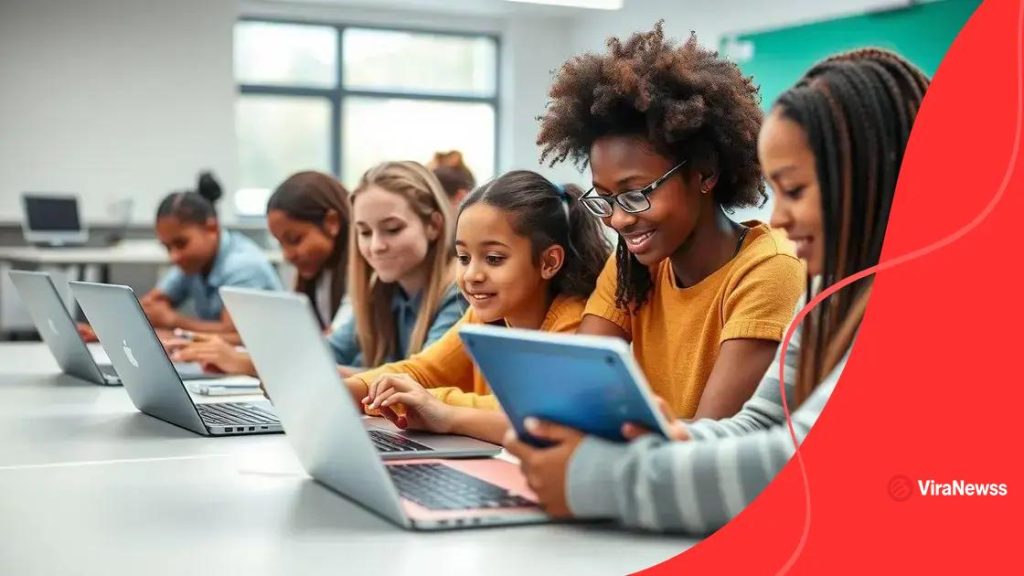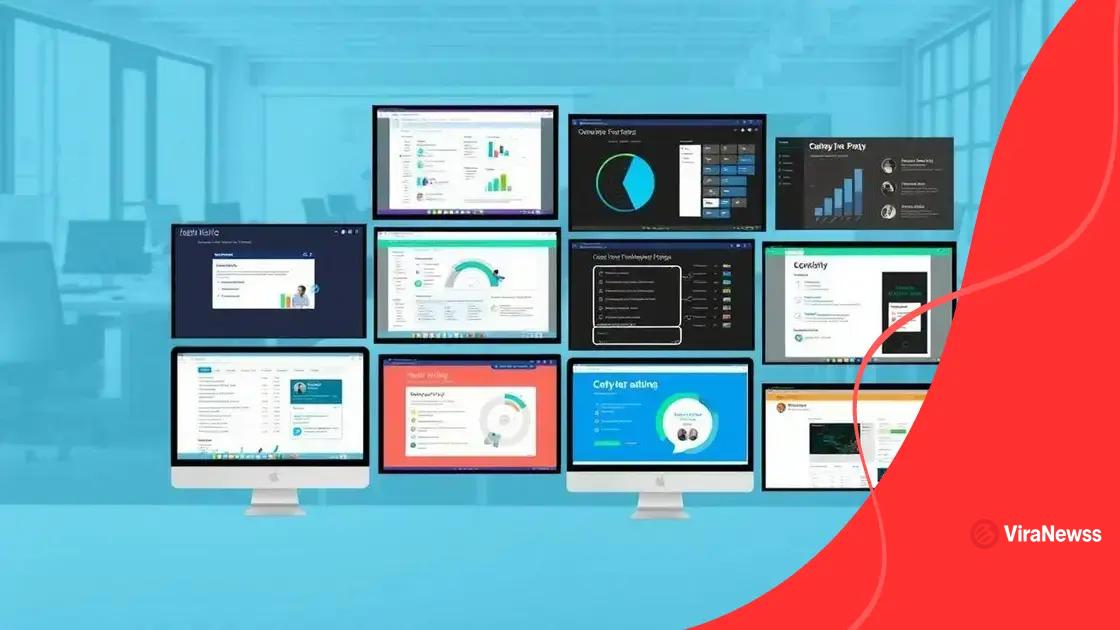Evaluation of the accessibility of online learning materials

Anúncios
The evaluation of the accessibility of online learning materials ensures equal access for all students, promoting inclusivity and improving the overall educational experience through best practices and innovative technologies.
Evaluation of the accessibility of online learning materials is essential in today’s increasingly digital education landscape. Have you ever wondered how accessible your favorite online course truly is? In this article, we will explore key factors that contribute to effective online learning accessibility.
Anúncios
Understanding accessibility in online learning
Understanding accessibility in online learning is crucial for creating a fair educational environment. Accessibility ensures that all students, regardless of their abilities, can benefit from online resources. This involves designing materials that everyone can use effectively.
Key Principles of Accessibility
There are several principles that guide the creation of accessible online learning materials. These principles include:
- Perceivable: Content must be presented in ways users can perceive it.
- Operable: Users should be able to navigate the content easily.
- Understandable: Information should be easy to understand for all students.
- Robust: Content should be compatible with different user agents, including assistive technologies.
Each of these principles plays a significant role in enhancing the learning experience. For instance, when materials are perceivable, they can be accessed by students with visual impairments who may use screen readers. When content is operable, students can navigate lessons freely, which promotes engagement.
Anúncios
Importance of Accessible Content
The importance of making online learning accessible cannot be understated. Accessible materials not only benefit students with disabilities but also enhance the overall learning experience for everyone. Students may face challenges that are not always visible, such as learning disorders or temporary impairments. By incorporating accessibility from the start, educators foster an inclusive atmosphere.
In addition, accessible materials comply with legal requirements in many regions, such as the Americans with Disabilities Act (ADA). Adhering to these standards ensures that educational institutions are providing equal opportunities.
Investing in the accessibility of online learning materials is not just a best practice; it’s a commitment to inclusive education. It involves regular evaluations and updates to ensure that materials meet evolving standards and student needs.
When online courses are designed with accessibility in mind, they encourage participation and collaboration, creating a richer educational experience for all students.
The importance of accessible online materials
The importance of accessible online materials cannot be overstated in today’s educational landscape. Developing online resources that everyone can use increases participation and engagement among students. When materials are accessible, they cater to various learning styles and needs.
Enhancing Learning Opportunities
Accessible materials provide equal learning opportunities for all. Students with disabilities, such as visual impairments, can benefit from resources designed with accessibility in mind. Screen readers can interpret text that is clearly structured and coded properly. This allows all students to engage with the material on a level playing field.
- Promotes Inclusion: Accessible materials make every student feel valued.
- Addresses Diverse Needs: Resources can be adapted for various learning preferences.
- Improves Overall Experience: Enhancing accessibility improves the experience for all learners, not just those with disabilities.
Additionally, creating accessible content minimizes frustration. When students encounter barriers, it impacts their motivation and success. Consider that when resources are designed and tested for accessibility, students can thrive and perform better.
Legal and Ethical Responsibility
Providing accessible online materials also fulfills a legal and ethical obligation. Educational institutions are required to comply with laws such as the Americans with Disabilities Act (ADA). Ensuring that materials are accessible not only promotes inclusivity but also protects against potential legal issues.
As educators and content creators, there’s a responsibility to create learning environments that embrace diversity. This commitment fosters a culture of respect and empowerment for all learners. By prioritizing accessibility, institutions can help break down barriers that prevent success.
Moreover, adopting accessibility measures can enhance the overall reputation of educational programs. When potential students see that a program prioritizes inclusivity, it can lead to greater interest and enrollment, showcasing a commitment to a diverse learning community.
Tools for evaluating online learning materials

Tools for evaluating online learning materials are essential for ensuring quality and accessibility. These tools help educators and content creators assess whether their resources meet the needs of all students. By using the right tools, institutions can identify potential barriers and improve learning experiences.
Types of Evaluation Tools
There are various tools available to evaluate online learning materials effectively. These tools range from automated software to manual checklists. Here are some common evaluation methods:
- Accessibility Checkers: These tools automatically assess online content for compliance with accessibility standards, such as the WCAG guidelines.
- User Testing: Gathering feedback from actual users helps identify real-world challenges and improvements needed in the learning materials.
- Peer Reviews: Collaboration with other educators can provide fresh insights and suggestions for enhancing accessibility and overall quality.
Employing a combination of these approaches often yields the best results. Regular evaluations can help maintain high standards for online materials. Additionally, staying up to date with the latest tools is crucial for optimizing accessibility.
Considerations for Tool Selection
When selecting tools for evaluating online learning materials, consider factors like usability, cost, and the specific needs of your audience. Some tools may fit better in certain educational contexts than others. For example, if the primary audience has visual impairments, a tool focusing on screen reader compatibility is essential. Moreover, collaboration tools that facilitate peer review can be beneficial in developing more inclusive content.
Many organizations offer free resources and tools for evaluation, allowing institutions to assess materials without incurring high costs. This fosters a culture of continuous improvement. Remember, the goal is to create an inclusive environment where all students can thrive. Tools that facilitate this process are invaluable for achieving educational equity.
Best practices for creating accessible content
Best practices for creating accessible content are essential for ensuring that all learners can engage with educational materials. Implementing these practices helps eliminate barriers that can hinder access to information, making learning more inclusive.
Using Clear Language
One of the keys to accessibility is using clear and simple language. Avoid jargon and overly technical terms whenever possible. This makes it easier for all students to understand the material. Short sentences and straightforward wording help keep the content engaging and easier to read.
Incorporating Various Formats
Another important practice is to provide materials in multiple formats. This could include text, audio, and video resources. Offering captions for videos and transcripts for audio helps accommodate different learning preferences and needs. Additionally, using alt text for images allows users with visual impairments to understand visual content better.
- Add Alt Text: Descriptive text for images helps users understand what they see.
- Use Headings Properly: Structure content using headings to guide readers through the material.
- Color Contrast: Ensure there is enough contrast between text and background colors, enhancing readability for everyone.
- Accessible Navigation: Make sure all links and buttons are easy to find and use.
Moreover, testing your content with real users, especially those with disabilities, provides valuable feedback. This helps identify any challenges that may not have been initially obvious. Continuous improvement based on feedback is vital for maintaining high accessibility standards.
Regular Reviews and Updates
Regularly reviewing and updating content is crucial to ensure ongoing accessibility. As technology and standards change, so should your materials. Staying informed about the latest accessibility guidelines, like the WCAG, ensures your content remains compliant and user-friendly.
By focusing on these best practices, educators and content creators can genuinely enhance the learning experience for all students. Creating accessible content not only complies with legal requirements but also fosters a positive and inclusive learning environment.
Future trends in online learning accessibility
Future trends in online learning accessibility are exciting and vital for promoting inclusive education. As technology evolves, so do the methods and tools we use to create accessible learning environments. These trends can help educators adapt and thrive in a digital-first learning landscape.
Increased Use of Artificial Intelligence
One significant trend is the use of artificial intelligence (AI) to enhance accessibility. AI can help personalize learning experiences for students with different needs. For instance, AI-driven applications can provide real-time captioning, sign language interpretation, or even tailored resources based on each student’s learning style.
Enhanced Interactivity and Engagement
Another trend focuses on creating more interactive and engaging content. Learning platforms are increasingly incorporating elements like virtual reality (VR) and augmented reality (AR). These technologies can offer immersive experiences for students, making learning more appealing and accessible.
- Real-time Feedback: Immediate responses help students learn more effectively.
- Gamification: Adding game-like elements can motivate students and enhance engagement.
- Collaborative Tools: Features that promote teamwork support diverse learning strategies.
Furthermore, accessibility features are becoming more integrated into standard educational tools. This means that users will benefit from enhanced options without needing to seek out specific accessibility tools separately. This integration fosters an environment where accessibility is the norm, not the exception.
Focus on Continuous Improvement
As we look towards the future, the focus on continuous improvement in accessibility will remain crucial. Educational institutions need to stay informed about emerging technologies and methods. Regular training for educators on the latest accessibility practices is essential to keep pace with rapidly evolving standards and student needs.
By embedding accessibility into every aspect of online learning, institutions will be better prepared to meet the diverse needs of their learners. This proactive approach not only aids compliance with legal standards but also promotes a richer educational experience for all students.
FAQ – Frequently Asked Questions about Accessibility in Online Learning
What does accessibility in online learning mean?
Accessibility in online learning means ensuring that all students, including those with disabilities, can effectively access and engage with educational materials.
How can technology improve accessibility?
Technology can improve accessibility by offering features like screen readers, captions, and multiple content formats, which help accommodate diverse learning needs.
Why are accessible materials important?
Accessible materials are important because they promote an inclusive learning environment, allowing all students equal opportunities to succeed.
What are some best practices for creating accessible content?
Best practices include using clear language, providing multiple formats, adding alt text for images, and regularly reviewing and updating materials.





